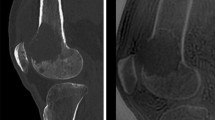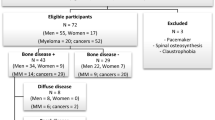Abstract
Objectives
To test the hypothesis that an accelerated, T1-weighted 3D CAIPIRINHA SPACE sequence with isotropic voxel size offers a similar performance to conventional T1-weighted 2D TSE (turbo spin echo) for the evaluation of bone tumor extent and characteristics.
Methods
Thirty-four patients who underwent 3-T MRI with 3DT1 (CAIPIRINHA SPACE TSE) and 2DT1 (TSE) were included. Sequence acquisition time was reported. Two radiologists independently evaluated each technique for tumor location, size/length, tumor-to-joint distance, signal intensity, margin/extraosseous extension, and signal-to-noise (SNR) and contrast-to-noise (CNR) ratios.
Results
Tumors were located in long (20/36, 55.5%) and pelvic (16/36, 44.4%) bones. 3DT1 sequence required an average acquisition time of 235 s (± 42 s, range 156–372), while two plane 2DT1 sequences combined (coronal and axial) had an average acquisition time of 381 s (± 73 s, range 312–523). There was no difference in the measurements of tumor length and tumor-to-joint distance (p = 0.95) between 3DT1 and 2DT1 images. Tumors were hypointense (17/36, 47.2% vs 17/36, 47.2%), isointense (12/36, 33.3% vs 12/36, 33.3%), or hyperintense (7/36, 19.4% vs 7/36, 19.4%) on 3DT1 vs 2DT1, respectively. Assessment of tumor margins and extraosseous extension was similar, and there was no difference in tumor SNR or CNR (p > 0.05).
Conclusions
An accelerated 3D CAIPIRINHA SPACE T1 sequence provides comparable assessments of intramedullary bone tumor extent and similar tumor characteristics to conventional 2DT1 MRI. For the assessment of bone tumors, the isotropic volume acquisition and multiplanar reformation capability of the 3DT1 datasets can obviate the need for 2DT1 acquisitions in multiple planes.
Key Points
• 3DT1 offers an equivalent performance to 2DT1 for the assessment of bone tumor characteristics, with faster and higher resolution capability, obviating the need for acquiring 2DT1 in multiple planes.
• There was no difference in the measurements of tumor length and tumor-to-joint distance obtained on 3DT1 and 2DT1 images.
• There was no difference in signal-to-noise ratio (SNR) or contrast-to-noise ratio (CNR) measures between 3DT1 and 2DT1.



Similar content being viewed by others
Abbreviations
- 3D:
-
Three dimensional
- 2D:
-
Two dimensional
- CAIPIRINHA:
-
Controlled Aliasing in Parallel Imaging Results in Higher Acceleration
- CNR:
-
Contrast-to-noise ratio
- FOV:
-
Field of view
- FSE:
-
Fast spin echo
- GRAPPA:
-
Generalized Autocalibrating Partial Parallel Acquisition
- IW:
-
Intermediate weighted
- MRI:
-
Magnetic resonance imaging
- PACS:
-
Picture archiving and communication system
- PD:
-
Proton density
- ROI:
-
Region of interest
- SD:
-
Standard deviation
- SI:
-
Signal intensity
- SNR:
-
Signal-to-noise ratio
- SPACE:
-
Sampling perfection with application-optimized contrasts using different flip angle evolution
- TE:
-
Echo time
- TR:
-
Repetition time
- TSE:
-
Turbo spin echo
- VIBE:
-
Volume intercalated breath-hold exam
- W:
-
Weighted
References
Notohamiprodjo M, Kuschel B, Horng A et al (2012) 3D-MRI of the ankle with optimized 3D-SPACE. Invest Radiol 47:231–239
Yoon MA, Hong SJ, Lee KC, Lee CH (2019) Contrast-enhanced magnetic resonance imaging of pelvic bone metastases at 3.0 T: comparison between 3-dimensional T1-weighted CAIPIRINHA-VIBE sequence and 2-dimensional T1-weighted turbo spin-echo sequence. J Comput Assist Tomogr 43:46–50
Shakoor D, Guermazi A, Kijowski R et al (2019) Cruciate ligament injuries of the knee: a meta-analysis of the diagnostic performance of 3D MRI. J Magn Reson Imaging 50:1545–1560
Del Grande F, Subhawong T, Weber K, Aro M, Mugera C, Fayad LM (2014) Detection of soft-tissue sarcoma recurrence: added value of functional MR imaging techniques at 3.0 T. Radiology 271:499–511
Van Dyck P, Gielen JL, Vanhoenacker FM et al (2012) Diagnostic performance of 3D SPACE for comprehensive knee joint assessment at 3 T. Insights Imaging 3:603–610
Jung JY, Yoon YC, Kim HR, Choe BK, Wang JH, Jung JY (2013) Knee derangements: comparison of isotropic 3D fast spin-echo, isotropic 3D balanced fast field-echo, and conventional 2D fast spin-echo MR imaging. Radiology 268:802–813
Kijowski R, Davis KW, Woods MA et al (2009) Knee joint: comprehensive assessment with 3D isotropic resolution fast spin-echo MR imaging--diagnostic performance compared with that of conventional MR imaging at 3.0 T. Radiology 252:486–495
Subhas N, Kao A, Freire M, Polster JM, Obuchowski NA, Winalski CS (2011) MRI of the knee ligaments and menisci: comparison of isotropic-resolution 3D and conventional 2D fast spin-echo sequences at 3 T. AJR Am J Roentgenol 197:442–450
Lee S, Jee WH, Jung JY, Lee SY, Ryu KS, Ha KY (2015) MRI of the lumbar spine: comparison of 3D isotropic turbo spin-echo SPACE sequence versus conventional 2D sequences at 3.0 T. Acta Radiol 56:174–181
Fritz J, Raithel E, Thawait GK, Gilson W, Papp DF (2016) Six-fold acceleration of high-spatial resolution 3D SPACE MRI of the knee through incoherent k-space undersampling and iterative reconstruction-first experience. Invest Radiol 51:400–409
Fritz J, Fritz B, Thawait GG, Meyer H, Gilson WD, Raithel E (2016) Three-dimensional CAIPIRINHA SPACE TSE for 5-minute high-resolution MRI of the knee. Invest Radiol 51:609–617
Naraghi A, White LM (2012) Three-dimensional MRI of the musculoskeletal system. AJR Am J Roentgenol 199:W283–W293
Ahlawat S, Morris C, Fayad LM (2016) Three-dimensional volumetric MRI with isotropic resolution: improved speed of acquisition, spatial resolution and assessment of lesion conspicuity in patients with recurrent soft tissue sarcoma. Skeletal Radiol 45:645–652
Putta T, Gibikote S, Madhuri V, Walter N (2016) Accuracy of various MRI sequences in determining the tumour margin in musculoskeletal tumours. Pol J Radiol 81:540–548
Vogler JB 3rd, Murphy WA (1988) Bone marrow imaging. Radiology 168:679–693
Shiga NT, Del Grande F, Lardo O, Fayad LM (2013) Imaging of primary bone tumors: determination of tumor extent by non-contrast sequences. Pediatr Radiol 43:1017–1023
Hwang S, Panicek DM (2007) Magnetic resonance imaging of bone marrow in oncology, Part 1. Skeletal Radiol 36:913–920
Fayad LM, Jacobs MA, Wang X, Carrino JA, Bluemke DA (2012) Musculoskeletal tumors: how to use anatomic, functional, and metabolic MR techniques. Radiology 265:340–356
Lecouvet FE, Pasoglou V, Van Nieuwenhove S et al (2020) Shortening the acquisition time of whole-body MRI: 3D T1 gradient echo Dixon vs fast spin echo for metastatic screening in prostate cancer. Eur Radiol 30:3083–3093
Kalia V, Fritz B, Johnson R, Gilson WD, Raithel E, Fritz J (2017) CAIPIRINHA accelerated SPACE enables 10-min isotropic 3D TSE MRI of the ankle for optimized visualization of curved and oblique ligaments and tendons. Eur Radiol 27:3652–3661
Fritz J, Ahlawat S, Fritz B et al (2019) 10-min 3D turbo spin echo MRI of the knee in children: arthroscopy-validated accuracy for the diagnosis of internal derangement. J Magn Reson Imaging 49:e139–e151
Fritz B, Bensler S, Thawait GK, Raithel E, Stern SE, Fritz J (2019) CAIPIRINHA-accelerated 10-min 3D TSE MRI of the ankle for the diagnosis of painful ankle conditions: performance evaluation in 70 patients. Eur Radiol 29:609–619
Del Grande F, Delcogliano M, Guglielmi R et al (2018) Fully automated 10-minute 3D CAIPIRINHA SPACE TSE MRI of the knee in adults: a multicenter, multireader, multifield-strength validation study. Invest Radiol 53:689–697
Zhai H, Lv Y, Kong X, Liu X, Liu D (2019) Magnetic resonance neurography appearance and diagnostic evaluation of peripheral nerve sheath tumors. Sci Rep 9:6939
Wolff SD, Balaban RS (1997) Assessing contrast on MR images. Radiology 202:25–29
Ahmad S, Stevenson J, Mangham C, Cribb G, Cool P (2014) Accuracy of magnetic resonance imaging in planning the osseous resection margins of bony tumours in the proximal femur: based on coronal T1-weighted versus STIR images. Skeletal Radiol 43:1679–1686
Onikul E, Fletcher BD, Parham DM, Chen G (1996) Accuracy of MR imaging for estimating intraosseous extent of osteosarcoma. AJR Am J Roentgenol 167:1211–1215
Thompson MJ, Shapton JC, Punt SE, Johnson CN, Conrad EU 3rd (2018) MRI identification of the osseous extent of pediatric bone sarcomas. Clin Orthop Relat Res 476:559–564
Tokuda O, Hayashi N, Matsunaga N (2004) MRI of bone tumors: fast STIR imaging as a substitute for T1-weighted contrast-enhanced fat-suppressed spin-echo imaging. J Magn Reson Imaging 19:475–481
Bellanova L, Schubert T, Cartiaux O et al (2014) MRI-based assessment of safe margins in tumor surgery. Sarcoma 2014:686790
Jin T, Deng ZP, Liu WF, Xu HR, Li Y, Niu XH (2017) Magnetic resonance imaging for the assessment of long bone tumors. Chin Med J (Engl) 130:2547–2550
O'Flanagan SJ, Stack JP, McGee HM, Dervan P, Hurson B (1991) Imaging of intramedullary tumour spread in osteosarcoma. A comparison of techniques. J Bone Joint Surg Br 73:998–1001
Del Grande F, Tatizawa-Shiga N, Jalali Farahani S, Chalian M, Fayad LM (2014) Chemical shift imaging: preliminary experience as an alternative sequence for defining the extent of a bone tumor. Quant Imaging Med Surg 4:173–180
Grossman JW, De Smet AA, Shinki K (2009) Comparison of the accuracy rates of 3-T and 1.5-T MRI of the knee in the diagnosis of meniscal tear. AJR Am J Roentgenol 193:509–514
Funding
The authors state that this work has not received any funding.
Author information
Authors and Affiliations
Corresponding author
Ethics declarations
Guarantor
The scientific guarantor of this publication is Laura Fayad.
Conflict of interest
The authors of this manuscript declare relationships with the following company: Siemens AG.
Statistics and biometry
No complex statistical methods were necessary for this paper.
Informed consent
Written informed consent was waived by the Institutional Review Board.
Ethical approval
Institutional Review Board approval was obtained.
Methodology
• retrospective
• observational
• performed at one institution
Additional information
Publisher’s note
Springer Nature remains neutral with regard to jurisdictional claims in published maps and institutional affiliations.
Rights and permissions
About this article
Cite this article
Luna, R., Fritz, J., del Grande, F. et al. Determination of skeletal tumor extent: is an isotropic T1-weighted 3D sequence adequate?. Eur Radiol 31, 3138–3146 (2021). https://doi.org/10.1007/s00330-020-07394-4
Received:
Accepted:
Published:
Issue Date:
DOI: https://doi.org/10.1007/s00330-020-07394-4




